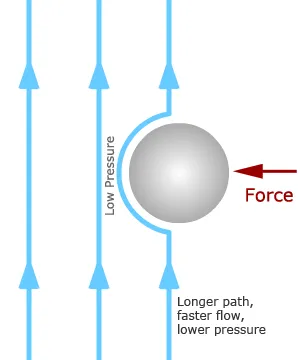Up and Away - Bernoulli's Way
Students observe the Bernoulli Principle in action: as the velocity of a fluid increases, the pressure exerted by that fluid decreases.
Learning Objectives
- Students learn that a fast-moving stream of air results in an area of low pressure that pulls surrounding air of higher pressure to it. This is commonly referred to as the Bernoulli Effect after scientist Daniel Bernoulli.
Materials
For each pair of students, you will need:
- Paper or clear plastic tubes of various lengths with a 3” opening at each end. Mailing tubes work well.
- 1 or more ping pong balls
- Hairdryer
Directions
- Turn the hairdryer on and point it and the stream of air upward at a 90-degree angle to the ground.
- Place the ping pong ball in the stream of air and let go of it.
- Place the tube like a hat on top of the ping pong ball floating in the air stream. Do not let go of the tube.
- Repeat the activity using tubes of various lengths. Tubes of various widths can also be explored.
Ask yourself the following questions
- Why does the ping pong ball float in the stream of air produced from the hairdryer?
- Why does the ping pong ball travel up and out of the tube?
- Why does the height reached by the ping pong ball vary depending on the length of the tube?
- Why does the ping pong ball travel farther with greater airspeed?
- What happens to the ping pong ball if you cover the top of the tube when it is placed on top of the airstream? Why?
Background
This activity is based on Bernoulli’s Principle, named after the Swiss mathematician and scientist Daniel Bernoulli (1700-1782) more than 250 years ago. It states that as a fluid’s velocity increases, the pressure exerted by that fluid decreases.

In this activity, the force of the "wind" from the hairdryer holds the ping pong ball up - but why doesn't the ball fly off to the side whenever the "wind" isn't directly centered on the ball?
If the ball is pushed to one side, the air flowing near the ball must take a longer path to flow all the way around the ball - compared to the straight path of air that is not near the ball. To "catch up" with the air that travels the shorter, straight route, the air flowing around the ball must move faster. Faster moving air has lower pressure, so the side of the ball towards the middle of the airflow has lower pressure on it. This causes the ball to be pushed back into the middle of the airflow whenever it strays towards the edge.
When the tube is placed on top of the ball, the air flowing around the ball and into the tube must follow a longer path, so it must flow faster. The air curving around the top of the ball and into the tube must flow fastest, so that is where the pressure is lowest. The low pressure above the ball causes the ball to be pushed up into the tube. Once the ball is in the tube, the air coming in behind cannot flow around the ball, so the flowing air pushes the ball along the tube like a shell being fired from a cannon. The ball zooms up the tube and out the top!
A good rhyme when it comes to air: High pressure to low, high pressure to low, that is where the air tries to go!